Kitchen Tools Worth Their Space
By Alice Osborne
Every once in awhile I run across a kitchen tool that truly makes life a little easier and so it earns some of my precious kitchen space. I'm a big believer that "Less is BEST!" and that all things in my physical world should earn their keep, so I'm picky about what I do give space to. Here are a couple items that have won the right to some of my prime real estate:
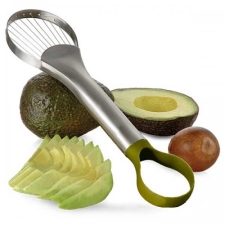 First, the Amco Avocado Pitter and Slicer. I use a lot of avocadoes because of their healthy fat content and great taste. I make salad dressings with them, put them in my green smoothies, and adorn our salads with them. So I'm using this tool daily. I calculate it's saving me a few hours a week by simplifying what used to be a pretty messy job.
First, the Amco Avocado Pitter and Slicer. I use a lot of avocadoes because of their healthy fat content and great taste. I make salad dressings with them, put them in my green smoothies, and adorn our salads with them. So I'm using this tool daily. I calculate it's saving me a few hours a week by simplifying what used to be a pretty messy job.
Cooking.com sells it for $15.95, but amazon.com sells it for $7.50 to $12.75. I looked around a few kitchen shops and Bed Bath and Beyond and didn't find it in my area, so amazon.com was my resource of choice.
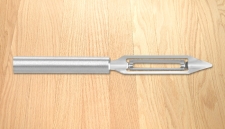 Next, the RADA vegetable peeler. I wrote about this last year when I first discovered and started using it. One year later I come back to you with raves! This is without a doubt the best peeler I've ever used.
Next, the RADA vegetable peeler. I wrote about this last year when I first discovered and started using it. One year later I come back to you with raves! This is without a doubt the best peeler I've ever used.
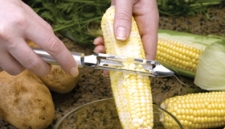 I love how it fits in my hand and I love what a thorough job it does (it's SO easy to use). I love how easy it easy to clean, how little space it takes up in my drawer, and how it looks. And I love that it's made in the USA from materials from the USA! You can find it on amazon.com for $7.45. RADA also offers a lifetime warranty on their products. The RADA website sells two versions-all stainless steel and a resin-handle version.
I love how it fits in my hand and I love what a thorough job it does (it's SO easy to use). I love how easy it easy to clean, how little space it takes up in my drawer, and how it looks. And I love that it's made in the USA from materials from the USA! You can find it on amazon.com for $7.45. RADA also offers a lifetime warranty on their products. The RADA website sells two versions-all stainless steel and a resin-handle version.
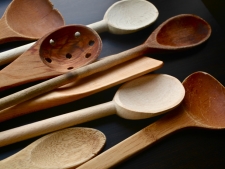 Now let's shift gears a bit and talk wooden utensils. In my years of clutter and organization consulting I find all sorts of just what this picture shows, flopping around in utensil drawers or crammed into counter utensil crocks. And invariably the homemaker is giving space to chipped, cracked, burnt, or otherwise really scruffy wooden kitchen tools.
Now let's shift gears a bit and talk wooden utensils. In my years of clutter and organization consulting I find all sorts of just what this picture shows, flopping around in utensil drawers or crammed into counter utensil crocks. And invariably the homemaker is giving space to chipped, cracked, burnt, or otherwise really scruffy wooden kitchen tools.
Folks, wooden kitchen tools are NOT created equal. If you're going to give space to them, go the quality-over-quantity route-be choosey and spend a little extra on those that won't chip, crack, or easily burn. Hardwood is always best, too, because the wood pores are tighter and so there's less chance of a bacteria issue.
All this said, when it comes to wooden spoons, chefs and home cooks alike can get pretty serious. So here for our guidance, from the pros at seriouseats.com, comes a list of criteria they use when buying wooden utensils:
Stirring is a spoon's primary task. It's got to have a wide surface area so that you can move a significant amount of food around the pot with limited effort.
Scraping is necessary to get cooking food off the bottom of the pot or for deglazing the browned bits off the bottom of the pan when making a pan sauce or braise. A good spoon should be able to do this efficiently and effectively.
Tasting as you go is a necessity. A good spoon will have a bowl large enough to lift up liquids or small pieces of solids, but not so large that you can't fit the end in your mouth.
And the main factors that affect these criteria are material and shape. Let's look at materials first. When it comes to stirring spoons, there are a couple of newfangled options on the market, but they both fall flat.
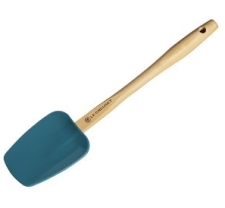 Heat-resistant nylon spoons like this version from Cuisinart ($8.99) is enjoying a brief moment in the sun these days, but the pros can't understand why. They are simply too hard to work properly. Sure, maybe they won't break after 9 years, but they won't give slightly the way a wooden spoon does.
Heat-resistant nylon spoons like this version from Cuisinart ($8.99) is enjoying a brief moment in the sun these days, but the pros can't understand why. They are simply too hard to work properly. Sure, maybe they won't break after 9 years, but they won't give slightly the way a wooden spoon does.
You may as well be using metal. They bungle the job exactly the way poorly shaped wooden spoon does, only worse, and for more money. Ludicrous.
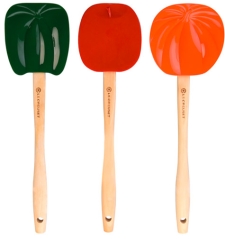 On the other hand, rubber and silicone spatulas, like the those from Le Creuset ($12) have the opposite problem. Their flexible heads are great for scraping out sauces or folding meringues, but have you ever tried deglazing a pan with one? It's a nonstarter.
On the other hand, rubber and silicone spatulas, like the those from Le Creuset ($12) have the opposite problem. Their flexible heads are great for scraping out sauces or folding meringues, but have you ever tried deglazing a pan with one? It's a nonstarter.
Only true wood will do, and the best are hard, lightweight, durable woods like beech, maple, or the new eco-friendly favorite of many manufacturers, bamboo. Wood is naturally a little giving, which allows you to more easily scrape and stir contents on the bottom of a pot or pan, pressing on the spoon to give better contact. It's also softer on the hands, and with time, will slowly conform to the shape of your hand and pot.
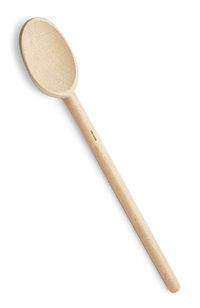 Now, shape. Round headed spoons like these cheap, functional models from H.A. Mack ($3.95) are the classic, consisting of a circular or oval-shaped bowl at the end of the handle. While they are good for stirring and for lifting soups and sauces for tasting, they have two major drawbacks. First off, because of their completely round shape, it's very difficult to make contact with a large surface of the pan bottom at the same time, making it a pain to scrape up browned bits when deglazing a stew or making a pan sauce.
Now, shape. Round headed spoons like these cheap, functional models from H.A. Mack ($3.95) are the classic, consisting of a circular or oval-shaped bowl at the end of the handle. While they are good for stirring and for lifting soups and sauces for tasting, they have two major drawbacks. First off, because of their completely round shape, it's very difficult to make contact with a large surface of the pan bottom at the same time, making it a pain to scrape up browned bits when deglazing a stew or making a pan sauce.
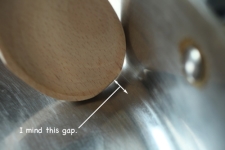 The second issue is this: They simply don't fit into the corners of a straight-walled sauté pan or Dutch oven. This is seriously frustrating when you're stirring a full pot of creamy risotto and the bits of shallot or rice continuously get stuck and burnt into the corners of the pan. It's the cooking equivalent of trying to read a book outdoors on a windy day--painfully annoying.
The second issue is this: They simply don't fit into the corners of a straight-walled sauté pan or Dutch oven. This is seriously frustrating when you're stirring a full pot of creamy risotto and the bits of shallot or rice continuously get stuck and burnt into the corners of the pan. It's the cooking equivalent of trying to read a book outdoors on a windy day--painfully annoying.
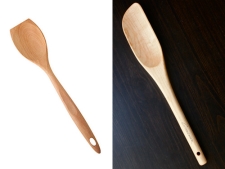 A couple of clever manufacturers have come up with solutions to both of these problems by flattening out the heads of their spoons. The picture shows two common choices. The completely flat-headed, symmetrical model, from Mario Batali ($5.95), at first glance seems like a fantastic option. It's got a flat head for scraping and a bowl for tasting out of. But unfortunately it also flares out around the sides, completely negating the benefits of its squared-off corners. You still can't fit it into the corner of a pot.
A couple of clever manufacturers have come up with solutions to both of these problems by flattening out the heads of their spoons. The picture shows two common choices. The completely flat-headed, symmetrical model, from Mario Batali ($5.95), at first glance seems like a fantastic option. It's got a flat head for scraping and a bowl for tasting out of. But unfortunately it also flares out around the sides, completely negating the benefits of its squared-off corners. You still can't fit it into the corner of a pot.
The model on the right is a solid maple number that costs a whopping $19.95 (from Williams-Sonoma). Its pointy edge effectively solves the corner dilemma, but it lacks a large enough flat surface for effective scraping. It's also got a handle that's too short, requiring dipping your knuckles in large quantities of anything you may be cooking. Annoying and unsanitary.
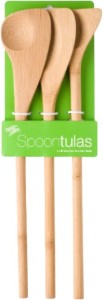 So while both do better than the classic round model, they still fall short of the mark. The winning model? One that combines all of the essential functions of a wooden spoon into one hot little multitasking number. The Spoontula Utensil Set, pictured here, from Bambu ($15.95 for set of three), is shaped just like a traditional round wooden spoon, giving you a small rounded bowl to taste out of. On the other side, it's got a flat-headed extension which ends in a sharp corner, allowing you to not only scrape the bottom of a pan effectively, but to scrape all the way up to the very edge of the pot.
So while both do better than the classic round model, they still fall short of the mark. The winning model? One that combines all of the essential functions of a wooden spoon into one hot little multitasking number. The Spoontula Utensil Set, pictured here, from Bambu ($15.95 for set of three), is shaped just like a traditional round wooden spoon, giving you a small rounded bowl to taste out of. On the other side, it's got a flat-headed extension which ends in a sharp corner, allowing you to not only scrape the bottom of a pan effectively, but to scrape all the way up to the very edge of the pot.
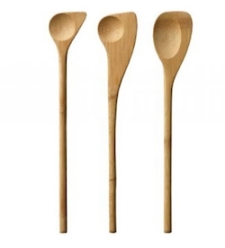 Finally a parting caveat: Do remember that, like knives, wives, and magic wands, no matter how much someone tells you that one is better than another, a good wooden spoon is an entirely personal decision. If it feels right in your hand, it's probably the right one for you.
Finally a parting caveat: Do remember that, like knives, wives, and magic wands, no matter how much someone tells you that one is better than another, a good wooden spoon is an entirely personal decision. If it feels right in your hand, it's probably the right one for you.
- www.amazon.com
- www.radacutlery.com
- www.lecreuset.com
- www.seriouseats.com [Photograph: Kenji Alt]

Alice Osborne
Weekly Newsletter Contributer since 2006

